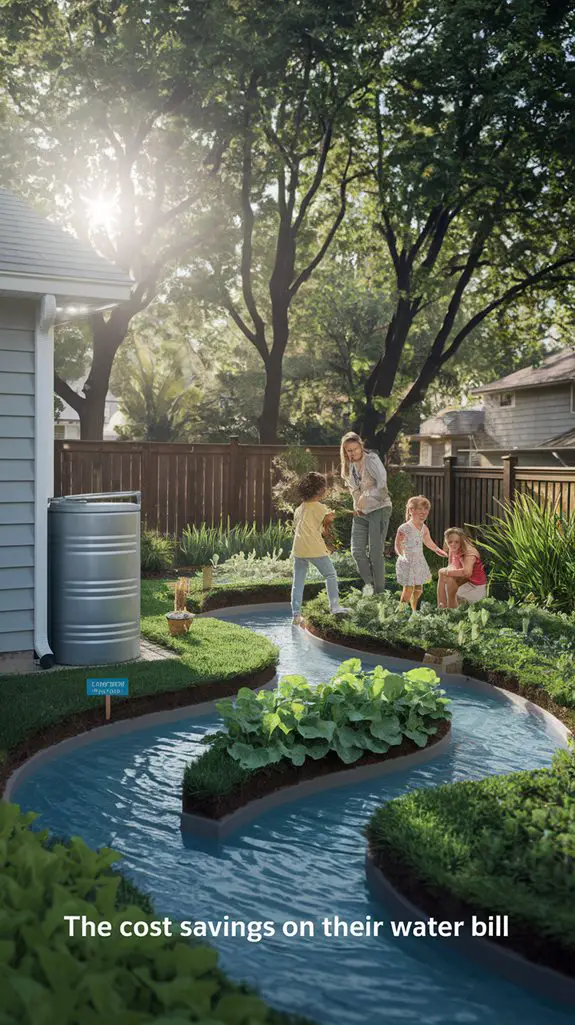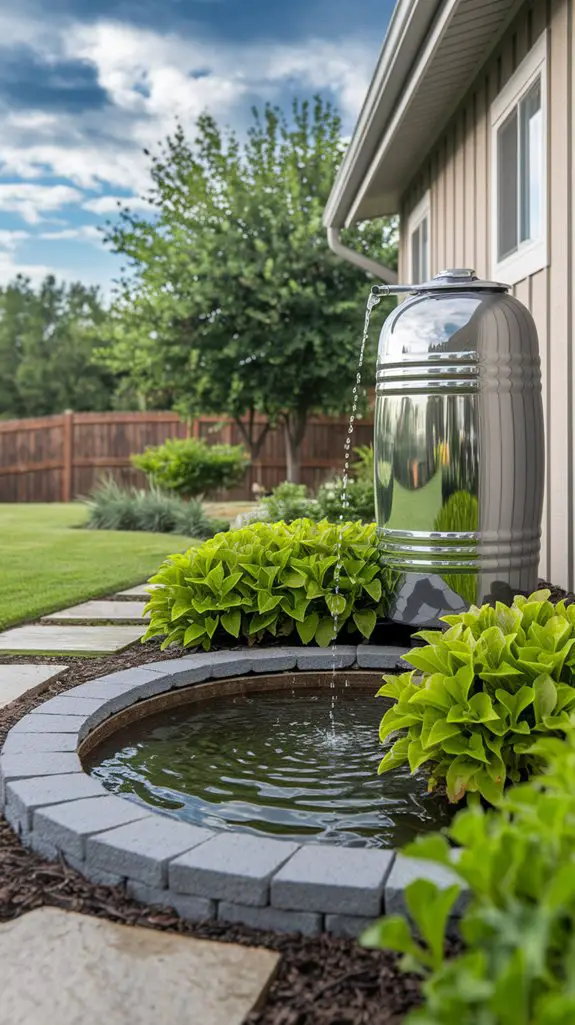In San Diego County, homeowners implementing simple rainwater management systems captured an average of 4,300 gallons annually per household during the 2021 drought. You’re likely missing similar opportunities in your own backyard. Suburban properties generate significant runoff that carries fertilizers, pesticides, and hydrocarbons directly into local waterways. The environmental consequences extend beyond your property line, while the financial benefits of proper management remain largely untapped. What’s flowing away from your home might be costing more than you realize.
The Hidden Environmental Impact of Suburban Runoff
While suburban neighborhoods appear tranquil and ecologically benign, they generate significant volumes of stormwater runoff that poses substantial environmental threats.
Your property’s impervious surfaces—rooftops, driveways, and patios—prevent natural soil infiltration, forcing rainfall to flow across chemically-treated lawns and into storm drains.
This runoff carries fertilizers, pesticides, automotive fluids, and microplastics into local waterways. Studies show that a typical quarter-acre suburban lot produces 10,000 gallons of runoff annually.
These pollutants trigger algal blooms, deplete oxygen levels, and contaminate drinking water sources. Additionally, the velocity of suburban runoff accelerates stream bank erosion, destroying aquatic habitats and increasing flooding risks downstream.
You’re directly connected to these watershed-scale impacts through your property’s drainage patterns, making your rainwater management choices environmentally consequential. Implementing rainwater harvesting practices in your garden can significantly mitigate these adverse effects.
Financial Benefits of Backyard Water Conservation

Although homeowners often focus on ecological advantages of rainwater management, implementing backyard water conservation systems delivers measurable financial returns.
You’ll reduce municipal water bills by 30-50% when utilizing collected rainwater for irrigation, offsetting installation costs within 2-3 years in most regions.
Property value increases by 3-7% with professionally designed water management features, while decreasing flood risk reduces insurance premiums by $45-120 annually.
Utility companies in 28 states offer rebates averaging $150-500 for rain barrel installation and permeable surface implementation.
The reduction in erosion-related foundation repairs saves homeowners $3,000-15,000 in potential long-term damage.
During drought restrictions, maintained access to stored water eliminates landscaping loss, preserving investments of $1,200-5,000 in established vegetation that would otherwise require replacement. Additionally, implementing maximum efficiency rainwater systems can further enhance your cost savings by ensuring optimal use of harvested water.
DIY Rainwater Collection Systems for Any Budget

Because rainwater collection systems can be implemented at various price points, homeowners don’t need extensive budgets to begin harvesting precipitation.
Entry-level setups utilizing a 55-gallon barrel connected to downspouts cost approximately $35-50, while mid-tier systems incorporating multiple interconnected containers range from $100-250.
For peak efficiency, install 1st-flush diverters ($15-30) to prevent debris contamination and mesh filters ($5-15) at collection points.
Your catchment potential equals roof area (ft²) × rainfall (in) × 0.623. A 1,500 ft² roof can collect 935 gallons from a 1-inch rainfall event.
Advanced systems featuring pumps ($75-200), automated filtration ($150+), and underground cisterns ($500+) offer expanded capacity but require technical knowledge for installation.
Consider UV stabilized containers for outdoor durability and implement overflow mechanisms to prevent foundation damage during heavy precipitation events. Additionally, understanding rainwater harvesting can significantly enhance your system’s effectiveness and sustainability.
Transforming Water Challenges Into Garden Opportunities
Collecting rainwater represents only the first step in thorough water management; putting that captured resource to ideal use transforms suburban challenges into ecological assets.
You’ll maximize this resource by implementing bioswales that filter 70-90% of pollutants while directing water to vegetation zones requiring higher moisture.
Consider integrating rain gardens with native species that tolerate both periodic inundation and drought conditions. These systems reduce runoff by 30-40% compared to traditional landscapes.
Strategic placement of permeable hardscapes allows infiltration at 50-300 inches/hour, replenishing groundwater while mitigating erosion.
You can further optimize water distribution through gravity-fed drip irrigation, which achieves 90% efficiency versus conventional sprinklers’ 50-70%. Additionally, incorporating sustainable outdoor water features can enhance the aesthetic appeal of your garden while utilizing harvested rainwater effectively.
Smart Technology Integration for Optimal Water Management
Smart technologies have revolutionized rainwater management efficiency, with IoT-enabled systems increasing water conservation by 15-30% compared to conventional methods.
These systems utilize real-time soil moisture sensors that transmit data at 5-minute intervals, allowing automatic adjustment of water distribution based on saturation levels.
You’ll find smart controllers particularly valuable—they integrate with weather forecasting APIs to anticipate precipitation events with 87% accuracy.
By deploying these controllers, you’re reducing unnecessary irrigation by accessing hyperlocal meteorological data within a 1-2 mile radius of your property.
Additionally, flow meters can detect usage anomalies as small as 0.5 gallons/hour, alerting you to potential leaks.
Modern systems store collected rainwater data in cloud platforms, enabling analysis of seasonal patterns and optimization of collection strategies based on historical precipitation metrics. Furthermore, rainwater systems for drought resistance can offer significant benefits to both environmental sustainability and economic savings for homeowners.
Regulatory Considerations and Neighborhood Benefits
While implementing residential rainwater systems, you’ll need to navigate a complex regulatory framework that varies greatly by jurisdiction. Most municipalities require permits for cisterns exceeding specific volumes (typically 1,000 gallons), and some restrict harvesting methods.
Check local building codes, HOA regulations, and watershed protection ordinances before installation.
Your rainwater management efforts extend benefits beyond property lines. Data shows neighborhoods with 30%+ adoption of residential rainwater systems experience 25-40% reduction in stormwater runoff during peak events. This decreases municipal infrastructure strain and mitigates flooding risks.
Studies from the EPA demonstrate that coordinated neighborhood rainwater management can reduce pollutant loading in local waterways by up to 65%, particularly for nitrogen, phosphorus, and suspended solids—contributing greatly to watershed health and ecological resilience. Additionally, integrating innovative rainwater systems can further enhance sustainability and efficiency in managing water resources.
Seasonal Maintenance Strategies for Sustainable Systems
To maintain ideal functionality of your rainwater management system throughout the year, seasonal maintenance must be performed according to a structured schedule that addresses changing environmental conditions.
In spring, clear debris from gutters and downspouts while inspecting for winter damage.
Summer requires monitoring overflow pathways and sediment buildup, as 65% of system failures occur due to blockages during heavy rainfall events.
Fall maintenance focuses on leaf removal from collection surfaces and filters, preventing decomposition that reduces water quality by up to 40%.
Winter preparation includes insulating exposed pipes where temperatures drop below 32°F and disconnecting certain components in freeze-prone regions.
In addition, consider implementing compact rainwater systems that are specifically designed to maximize efficiency in smaller suburban backyards.
Document your maintenance with photographs to track system changes over time, as consistent upkeep extends system lifespan by an average of 7-10 years compared to reactively maintained installations.
Conclusion
By optimizing your backyard’s rainwater management, you’re creating a measurable defense against the 80-95% increase in runoff that typically occurs in suburban developments. Visualize each drop captured—preventing 30-40% of nitrogen and phosphorus pollutants from entering local watersheds. Your integrated system isn’t just aesthetically pleasing; it’s a quantifiable ecosystem service, reducing municipal stormwater volume by 50-80% during moderate rainfall events while decreasing your water utility costs by 30-50% annually.




